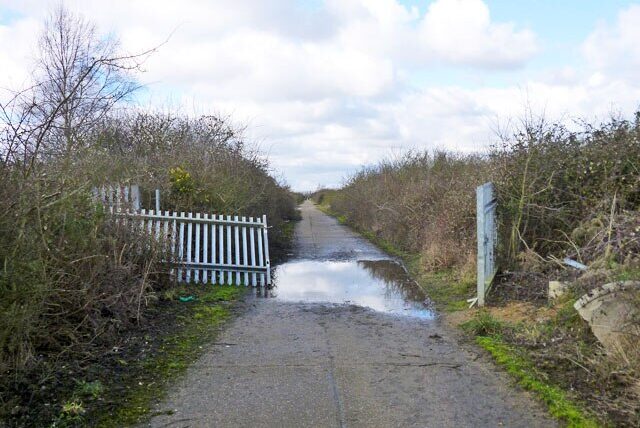
“You’ve got to see this!” Marc Outten pushes through tangles of blackthorn, skirts bramble mounds the size of buses, and passes meadows of wildflowers. You expect a great wildlife spectacle ahead.
Instead, we arrive at a vast, empty circle of asphalt, 70 metres across – the skeletal remains of an unfinished oil refinery.
“You’ll find rare bees and reptiles around the edge and you’ve got these lovely stonecrops and lichens,” enthuses Outten, a naturalist and RSPB’s site manager for Canvey Wick nature reserve. The derelict asphalt pad is buzzing with rare nature.
This “ruin” – where old streetlamps rise awkwardly above sprawling scrub – looks like a scene from a post-apocalyptic London. Yet in decay, this brownfield site on the Thames at Canvey Island has become one of the richest habitats in Britain, home to 3,200 species including endangered shrill carder bees, pantaloon bees, water voles, cuckoos and long-eared owls.
This year, Canvey Wick marks 20 years as a Site of Special Scientific Interest (SSSI), just as conservationists warn that other brownfield havens face threats from development across the Thames Gateway.
The Tilbury ash fields – supporting 185 invertebrate species of conservation concern, including the great sneak-spider – could be destroyed by a planned port expansion. A proposed Google data centre near Lakeside threatens another wildlife site, where nightingales and rare insects such as the brown-banded carder bee still cling on.
Canvey Wick shows what happens when such places are protected. Since the Land Trust acquired it, and the RSPB and Buglife took on management, its 93 hectares (230 acres) have flourished. Of its 3,200 species, nearly 12% are rare, scarce, threatened or near-threatened.
Take nightingales: absent eight years ago, they now hold 21 territories in thickets of blackthorn, hawthorn and bramble – a crucial new refuge for this beloved, endangered songbird.
“People assume that brownfield sites are very low value for biodiversity – until they see what a brownfield site can really do,” said Outten, on a tour of the site during which we find pantaloon bees, spectacular Jersey tiger moths and increasingly rare wall brown butterflies. “If brownfield sites are left to sit around for a while, they develop into really rich habitats. This would’ve been a very desolate space full of sand, concrete and tarmac and now we’ve got this wonderful nature reserve. There’s so much structural diversity and the more structural diversity you have, the more biodiversity you have – that’s what makes this place so special.”
Ironically, Canvey Wick only exists because humans ruined what was once grazing marsh.
In the 1970s, work began on an oil refinery. The ground was raised with dredgings from the Thames – sand, shingle, even seashells. Concrete roads and lighting went in. Thirty-two and a half asphalt pads were laid for huge storage tanks. Then came the 1973 oil price shock, and the project was abandoned.
Over the next half-century, nature rushed in. The mix of soils and hot microclimates drew extraordinary numbers of invertebrates. Today the site boasts 250 species of bees, wasps and ants, including the brown-banded carder bee, five-banded weevil-wasp and carrot mining bee. They thrive on an odd mix of flowers, from bristly oxtongue to everlasting pea.
But as vegetation thickens, conservationists face tough choices. Scrub benefits nightingales but shades out heat-loving insects. When designated in 2005, scrub covered just 15% of the site; now it’s closer to 70%.
“Some scrub is great but having that open mosaic flower-rich grassland is really important,” says Outten. “How do you strike the balance between clearing areas and retaining nightingale habitat? A lot of this is cutting-edge stuff. ‘Restoring’ brownfield is not something many organisations have got into.”
A recent three-year project cut back scrub, opened bare sandy scrapes for insects and adders, and cleared ditches for rare dragonflies like the scarce emerald damselfly. Wildflowers and insects are surging back.
Campaigners hope Canvey Wick inspires the creation of more brownfield reserves.
“Canvey Wick demonstrates how brownfield sites can be transformed into vibrant green spaces that serve the community and provide important habitats for wildlife,” says Alan Carter, the chief executive of the Land Trust. “We are extremely proud of the regeneration efforts carried out since taking on the ownership of the site in 2012. The site is now one of the top locations in Britain for endangered invertebrates, an impressive achievement.”
Swanscombe peninsula was safeguarded in 2021 when Natural England granted SSSI status, but groups like Buglife want similar protection extended to places such as Tilbury ash fields. Though “Thames estuary invertebrates” are listed in Natural England’s pipeline of potential SSSI designations, the body has been criticised for failing to act quickly enough.
Carl Bunnage, head of nature policy at RSPB, said: “Brownfield sites are not always just dead, ugly and abandoned spaces. Indeed, as Canvey Wick shows, they can provide specialist habitats and be havens for nature – full of life of all kinds. With the government currently driving reforms to the planning system in England, and prioritising the re-development of brownfield sites, it is vital that the nature-value of sites is properly assessed before planning decisions are taken.”
Conservationists argue that even small-scale interventions could help. Piles of sand or crushed concrete may look scruffy, but they create the soils and microclimates where wildflowers and invertebrates thrive.
Outten, who grew up nearby, hopes Canvey will spark more such sites – a network of reserves where rare species can flourish and local people can connect with them.
“People feel passionately about it. We want to strike the balance between giving people a place where they can access green space but also protect the species that the site is important for. It’s a unique place. There’s nowhere else like it,” he said.
“People feel passionately about it. We want to strike the balance between giving people a place where they can access green space but also protect the species that the site is important for. It’s a unique place. There’s nowhere else like it,” he said.
——————————————————————————
At Natural World Fund, we are passionate about restoring habitats in the UK to halt the decline in our wildlife.

